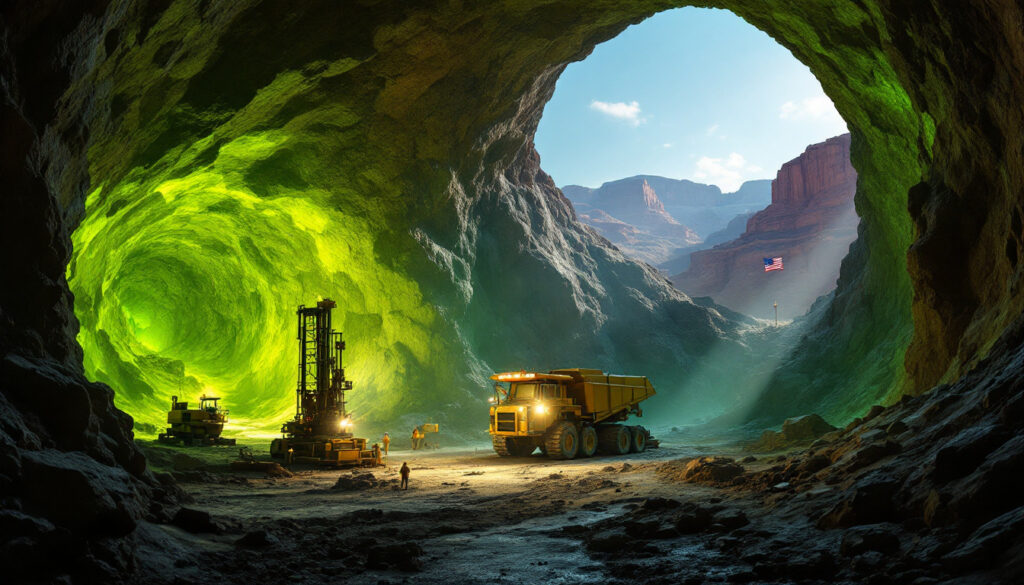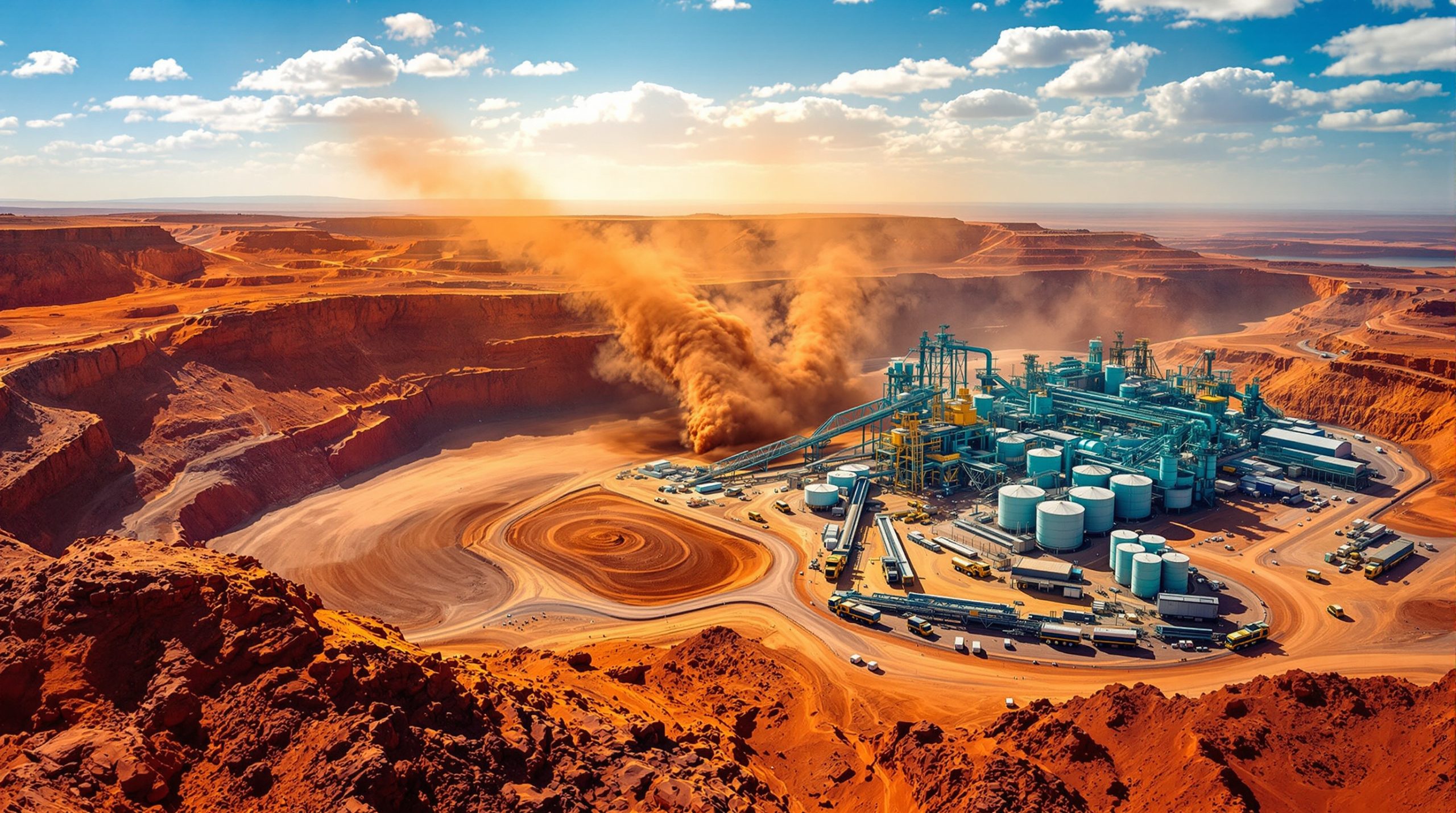US Fast-Tracks Anfield Energy's Velvet-Wood Uranium Mine Permit Review
The United States government has taken extraordinary steps to accelerate the approval process for Anfield Energy's Velvet-Wood uranium and vanadium mine in Utah. This unprecedented move signals a dramatic shift in how critical mineral projects are being prioritized to address national security concerns and energy independence goals.
What Is the Velvet-Wood Uranium Mine Project and Why Is It Being Fast-Tracked?
The Velvet-Wood project represents a strategic initiative to revitalize domestic uranium and vanadium production in the United States. Located in San Juan County, Utah, this mine project has captured federal attention due to its potential to reduce America's dangerous dependence on foreign mineral sources.
Anfield Energy's project stands out for several key reasons:
- The mine will utilize existing Velvet Mine workings, minimizing the need for new development
- Only three acres of new surface disturbance will be required, compared to typical uranium mines that disturb 10-50 acres
- The site will produce both uranium and vanadium—two minerals officially designated as critical for national security
- It represents a rare opportunity to develop a domestic source of minerals currently dominated by geopolitical competitors
The project's fast-tracking reflects growing concerns about America's 99% dependence on imported uranium concentrate (as reported by the U.S. Energy Information Administration's 2023 Annual Report). This vulnerability has been deemed an unacceptable national security risk by the current administration.
The Strategic Importance of Velvet-Wood
Velvet-Wood's significance extends beyond just adding another mine to America's resource portfolio. The project represents a cornerstone in rebuilding a domestic uranium supply chain that has deteriorated over decades.
Secretary of the Interior Doug Burgum highlighted this urgency, stating: "America is facing an alarming energy emergency because of the prior administration's Climate Extremist policies." This perspective frames the expedited review as a necessary correction to previous policies that prioritized environmental protection over energy security.
The mine's dual production capability—extracting both uranium and vanadium—is particularly valuable. While uranium powers nuclear energy, vanadium serves as a critical component in high-strength steel alloys used in infrastructure, defense applications, and emerging energy storage technologies.
Industry Insight: Vanadium's growing importance in grid-scale energy storage through redox flow batteries makes it increasingly strategic for renewable energy integration, a fact often overlooked in discussions about critical minerals energy security.
How Is the US Government Expediting the Permitting Process?
Unprecedented 14-Day Review Timeline
In what mining experts describe as a regulatory revolution, the Bureau of Land Management (BLM) has been directed to complete the environmental permitting review for the Velvet-Wood project within just 14 days. This timeframe represents a staggering acceleration compared to traditional review periods that typically extend from 2-5 years for uranium projects.
This expedited process is being enabled through:
- Emergency procedures established under the national energy emergency declaration of January 20, 2025
- Special authorities invoked under existing regulations for:
- National Environmental Policy Act (NEPA)
- National Historic Preservation Act (NHPA)
- Endangered Species Act (ESA)
The government is utilizing NEPA's "emergency circumstances" clause (40 CFR § 1506.12), which allows for abbreviated environmental reviews during declared emergencies.
Legal Framework for Expedited Review
The legal foundation for this accelerated timeline stems from President Donald Trump's 2025 energy emergency declaration (Federal Register, Presidential Proclamation 9996). This declaration provides federal agencies with extraordinary authority to bypass standard review procedures for projects deemed critical to national security or energy independence.
Acting Assistant Secretary Adam Suess emphasized this priority, noting: "By fast-tracking the review process for the project, we are driving American Energy Dominance."
The expedited process builds upon precedents established in the 2020 FAST-41 Act, which created streamlined permitting process for critical infrastructure projects. However, the 14-day timeline for Velvet-Wood represents an unprecedented acceleration even compared to those provisions.
| Typical Mining Permit Timeline | Velvet-Wood Timeline | Acceleration Factor |
|---|---|---|
| 2-5 years | 14 days | 52-182x faster |
| Multiple public comment periods | Limited public input | Significantly reduced |
| Detailed environmental impact statement | Abbreviated assessment | Focused on essential requirements |
Why Does the US Need Domestic Uranium and Vanadium Production?
Current US Dependency on Foreign Sources
The United States faces alarming supply vulnerabilities for both uranium and vanadium—dependencies that have been identified as significant national security risks. According to government data:
- Uranium: 99% of uranium concentrate used in the US was imported in 2023
- Major suppliers: Russia, Kazakhstan, Uzbekistan—all countries with complicated or adversarial relationships with the United States
- Disruption risk: Russia suspended uranium exports to the U.S. in April 2024, highlighting supply chain fragility
The vanadium situation presents similar concerns:
- Import dependency: Nearly 50% of U.S. vanadium consumption came from foreign sources in 2024
- Market dominance: China controls 62% of global vanadium production (USGS, 2024)
- Strategic applications: Vanadium is essential for aerospace, defense, and energy technologies
U.S. nuclear reactors consumed 46.7 million pounds of uranium in 2023 (EIA, 2024), with almost all of that material sourced from overseas. This dependency creates vulnerabilities for America's largest source of clean electricity.
Strategic Applications of Uranium and Vanadium
Uranium Applications:
- Nuclear energy: Fuel for 93 operating civilian nuclear reactors providing approximately 20% of U.S. electricity
- Naval propulsion: Power source for the U.S. Navy's aircraft carriers and submarine fleet
- National defense: Essential component in nuclear weapons production and maintenance
- Medical applications: Used in radioisotopes for cancer treatments and advanced diagnostic imaging
Vanadium Applications:
- Steel production: Critical alloying element that increases strength-to-weight ratios by up to 30%
- Aerospace materials: Essential component in titanium alloys used in aircraft and spacecraft
- Infrastructure: Enhances durability of bridges, buildings, and pipelines
- Energy storage: Key material in grid-scale vanadium redox flow batteries capable of storing renewable energy
Technical Note: Vanadium redox flow batteries offer unique advantages for grid-scale energy storage, including 20+ year lifespans without degradation, unlimited discharge cycles, and non-flammable chemistry—making them increasingly important for renewable energy integration.
What Are the Broader Implications for US Energy and Mineral Policy?
The "American Energy Dominance" Strategy
The expedited review of the Velvet-Wood project represents a tangible manifestation of the current administration's "American Energy Dominance" strategy. This approach marks a significant departure from previous energy and mineral policies:
- Regulatory philosophy shift: Characterizing previous climate-focused policies as "extremist" and detrimental to energy security
- National security framing: Positioning energy independence as vital to America's security interests
- Domestic production emphasis: Allocating $2.5 billion for critical mineral projects in 2025 (U.S. Department of Energy, 2025 Budget)
- Regulatory streamlining: Reducing permitting barriers across the energy and mineral sectors
The White House has explicitly stated: "Reducing regulatory barriers is central to energy independence" (WhiteHouse.gov, March 2025). This position anchors the administration's broader approach to critical minerals and energy resources.
Anfield Energy's Integrated Production Strategy
The Velvet-Wood project is not an isolated endeavor but part of Anfield Energy's comprehensive uranium production strategy. The company's approach includes:
- Mill ownership: Controlling the Shootaring Canyon uranium mill in Utah
- Vertical integration: Creating capability to mine uranium ore and process it into yellowcake (U₃O₈) concentrate
- Supply chain control: Establishing a fully domestic uranium supply chain from extraction to usable fuel precursor
- Reduced import reliance: Decreasing dependence on foreign uranium concentrate sources
This integrated strategy aligns with broader government goals to rebuild domestic mineral supply chains that have atrophied over decades of offshoring and import reliance.
How Does This Project Connect to Broader Critical Mineral Initiatives?
Recent Critical Minerals Emergency Declaration
The Velvet-Wood project expedited review follows directly from the March 2025 critical minerals emergency declaration (Federal Register, Proclamation 10101). This declaration established a framework for:
- Priority permitting: Fast-tracking approval processes for mines producing designated critical minerals
- Foreign dependency reduction: Setting ambitious targets to cut reliance on China by 75% by 2030
- Regulatory efficiency: Eliminating what the administration terms "unnecessary barriers" to domestic production
- Economic revitalization: Supporting mining communities through job creation and economic development
The Trump administration has stated that these initiatives will create "good-paying American jobs" while strengthening national security by reducing dependence on potentially hostile foreign suppliers.
Government Statements on Energy Security
Key government officials have consistently framed the expedited review process for projects like Velvet-Wood as essential to national interests:
Secretary of the Interior Doug Burgum has emphasized addressing what he terms an "alarming energy emergency" created by previous policies. Acting Assistant Secretary Adam Suess has directly connected the project to broader efforts aimed at "driving American Energy Dominance."
This framing puts mineral production in a national security context rather than strictly economic or environmental terms—a significant policy reorientation that places strategic concerns at the forefront of permitting decisions.
In comparison, the European Union has pursued its own Critical Raw Materials Act (European Commission, 2023), which similarly aims to secure supply chains but maintains more rigorous environmental review processes and timelines, typically ranging from 6-24 months even for priority projects.
What Environmental and Community Considerations Are Involved?
Minimizing Environmental Impact
Anfield Energy and government officials have emphasized the project's reduced environmental footprint compared to typical mining operations:
- Existing infrastructure: Utilization of previously developed mine workings
- Minimal new disturbance: Only three acres of new surface disturbance required
- Regional context: This represents just 0.0004% of San Juan County's total land area
- Reclamation potential: Opportunity for accelerated reclamation of previously disturbed areas
A BLM spokesperson noted: "Projects using existing infrastructure prioritize environmental stewardship" (BLM.gov, April 2025). The project must still comply with the reclamation requirements under the 1977 Surface Mining Control Act (30 U.S.C. § 1251), which mandates restoration of mined lands to productive use.
Questions About Expedited Environmental Review
The unprecedented 14-day review timeline has raised important questions from environmental experts and community stakeholders about:
- Assessment thoroughness: Whether complex environmental impacts can be adequately evaluated in such a compressed timeframe
- Stakeholder consultation: Limited opportunity for community input and tribal consultation
- Monitoring protocols: Questions about groundwater monitoring requirements, particularly important for uranium mining
- Regulatory precedent: Concern that this expedited process could become standard practice for other projects
Important Note: While uranium mining technologies have improved significantly since the 1950s-1970s era that left environmental legacies in parts of the Southwest, comprehensive groundwater monitoring remains essential for protecting water resources in arid regions like San Juan County.
Environmental organizations have advocated for closer adherence to EPA Technical Guides for groundwater monitoring at uranium mines, which recommend at least 12 months of baseline data collection before mining begins—a timeframe incompatible with the expedited 14-day review.
FAQ: Velvet-Wood Uranium Project
What minerals will the Velvet-Wood project produce?
The project will produce both uranium and vanadium, two minerals considered critical for national security, energy production, and industrial applications. Uranium primarily serves nuclear energy needs, while vanadium enhances steel strength and enables energy storage technologies.
How quickly will the environmental review be completed?
The Bureau of Land Management has been directed to complete the review within 14 days, an unprecedented acceleration compared to typical review periods that can take 2-5 years for uranium projects.
Why is domestic uranium production considered important?
The US currently imports 99% of its uranium concentrate, creating vulnerabilities in the supply chain for nuclear energy, naval propulsion, and defense applications. Recent US uranium market disruption has highlighted these vulnerabilities.
What is the significance of the Shootaring Canyon uranium mill?
Anfield Energy owns this mill in Utah and plans to restart it to process uranium ore into uranium concentrate, creating a more complete domestic supply chain. This vertical integration strategy reduces reliance on foreign processing facilities.
How does this project relate to broader US energy policy?
The expedited review aligns with the administration's focus on "American Energy Dominance" and reducing dependence on foreign suppliers for critical minerals. It represents a shift from climate-focused policies to energy security priorities.
The Future of Critical Minerals Development in the US
The Velvet-Wood project's unprecedented permitting acceleration may signal a fundamental transformation in how the United States approaches critical mineral development. Industry analysts suggest this could be the first of many such expedited reviews, potentially reshaping America's resource landscape.
As domestic production capacity rebuilds, questions remain about balancing legitimate national security concerns with environmental protection and community engagement. The ultimate success of projects like Velvet-Wood will likely influence whether this accelerated approach becomes the new standard or remains an exceptional response to perceived emergency conditions.
Recent uranium market volatility and Paladin uranium mining halt in Namibia have further emphasized the fragility of global uranium supply chains. According to the Department of Interior press release, these developments underscore why domestic uranium production has become a national priority.
Disclaimer: This article discusses ongoing policy changes and mineral development projects. The regulatory environment surrounding critical minerals remains dynamic, and timelines, processes, or project details may evolve as circumstances change.
Interested in the Next Major Mineral Discovery on the ASX?
Discovery Alert's proprietary Discovery IQ model instantly notifies investors about significant ASX mineral discoveries, turning complex data into actionable investment insights before the broader market reacts. Explore how historic discoveries have generated substantial returns by visiting Discovery Alert's dedicated discoveries page.




